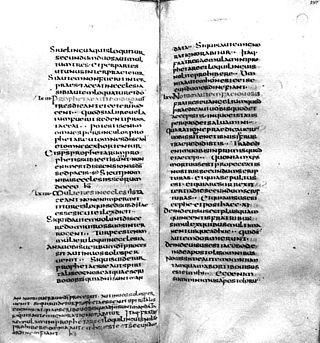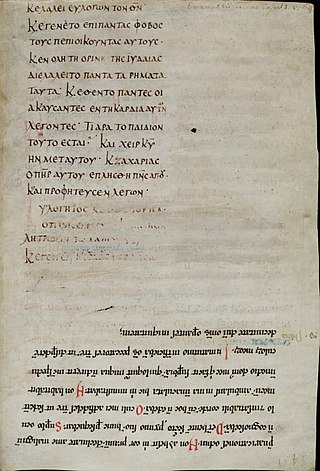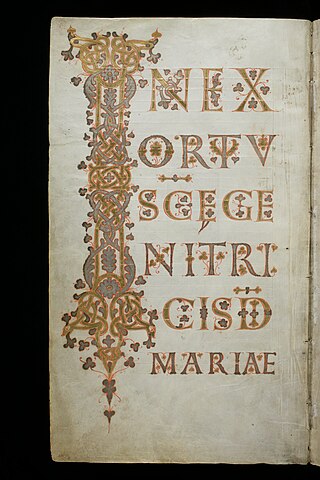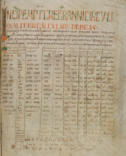
The Irish Gospels of St. Gall or Codex Sangallensis 51 is an 8th-century Insular Gospel Book, written either in Ireland or by Irish monks in the Abbey of St. Gall in Switzerland, where it is now in the Abbey library of St. Gallen as MS 51. It has 134 folios. Amongst its eleven illustrated pages are a Crucifixion, a Last Judgement, a Chi Rho monogram page, a carpet page, and Evangelist portraits.

The Uspenski Gospels, Minuscule 461, ε 92 (Soden), are a New Testament minuscule manuscript written in Greek, dated to 835 AD, and now in St Petersburg in Russia. They are the oldest known dated manuscript of the New Testament; it was not customary for Greek scribes to date their work at the time.

The Codex Fuldensis, also known as the Victor Codex, designated by F, is a New Testament manuscript based on the Latin Vulgate made between 541 and 546. The codex is considered the second most important witness to the Vulgate text; and is also the oldest complete manuscript witness to the order of the Diatessaron. It is an important witness in any discussion about the authenticity of 1 Corinthians 14:34–35 and the Comma Johanneum. It is one of the earliest dated manuscripts of the New Testament. It was corrected until 2 May, 546 AD.

Leiden University Library, VLQ 79, also called the Leiden Aratea, is an illuminated copy of an astronomical treatise by Germanicus, based on the Phaenomena of Aratus. The manuscript was created in the region of Lorraine and has been dated to around 816. It was produced at the court of Louis the Pious, who ruled from 814–840. It is one of the four Carolingian codices that were produced in his court. There are many translations and copies of this text, so it is very well known throughout the Middle East and Europe.

The abbey library of Saint Gall is a significant medieval monastic library located in St. Gallen, Switzerland. In 1983, the library, as well as the Abbey of St. Gall, were designated a World Heritage Site, as "an outstanding example of a large Carolingian monastery and was, since the 8th century until its secularisation in 1805, one of the most important cultural centres in Europe". It is one of the oldest monastic libraries in the world.

Codex Sangallensis, designated by Δ or 037, ε76, is a Greek-Latin diglot uncial manuscript of the four Gospels. Using the study of comparative writing styles (palaeography), it is usually dated to the 9th century CE, though a few palaeographers would place it in the 10th century CE. It was given its current name by biblical scholar Johann Martin Augustin Scholz in 1830.

Uncial 0130, ε 80 (Soden), is a Greek uncial manuscript of the New Testament, dated palaeographically to the 9th-century. Formerly it was labelled by Wc.
Codex Sangallensis is the designation of codices housed at the Abbey library of Saint Gall in St. Gallen. The codices are indexed with a continuous Arabic number of up to four digits. Many of the codices have been digitized through the e-codices project in Switzerland, with over 2000 of them freely available online.

Codex Sangallensis 1395 is a 19th-century compilation of fragments, and includes a 5th-century Latin manuscript of the New Testament, designated by Σ. The text, written on vellum, is a version of the Latin Vulgate.

The Codex Sangallensis 63, designated by S in some critical editions of the Bible, is a 9th-century Latin manuscript of the New Testament. The text, written on vellum, is a version of the Vulgate and contains the text of the Acts of the Apostles, Epistles, Book of Revelation, and non-biblical material. The manuscript has not survived in a complete condition, some parts of it have been lost. The original manuscript did not contain the Comma Johanneum, but it was added by a later hand on the bottom margin.

The Codex Sangallensis 907, designated S, is an 8th-century Latin manuscript of the New Testament. The text, written on vellum, is a version of the Latin Vulgate Bible. It contains the text of the Catholic epistles, Book of Revelation, and non-biblical material. The manuscript did not survived in a complete condition and some parts of it has been lost. The codex contains the Comma Johanneum.
Minuscule 881, Θε51, is a 15th-century Greek minuscule manuscript of the New Testament on paper. It has complex contents.

The Golden Psalter of St. Gall is a Carolingian Gallican psalter produced in the late 9th century, probably begun in West Francia, later continued in St. Gall Abbey.

The Evangelium longum is an illuminated manuscript Latin evangeliary that was made around 894 at the Abbey of Saint Gall in Switzerland. It consists of texts drawn from the Gospels for the use of the preacher during Mass.
The St. Gall Priscian Glosses, abbreviated Sg., is an Irish manuscript of the Latin grammar Institutiones grammaticae by Priscian, held by the Abbey Library of St. Gall. It contains 9412 glosses, including 3478 in Old Irish. Together with the Würzburg glosses on the Epistles of St Paul and the Milan glosses on a Commentary on the Psalms they provide the main source of Old Irish writing available today and thus serve as an important reference for linguistic research on Old Irish.

The Codex Sangallensis 484 is an early medieval music manuscript, produced in the abbey of St. Gallen and stored in the Abbey Library in St. Gallen. The manuscript is known for its exhaustive collection of so-called tropes, meaning melodic or textual extensions to previously existing liturgic chants. As this particular manuscript is among the most extensive collections of such tropes from the eastern Frankish kingdom, it plays an important role in the history of music.

The Codex Sangallensis 381 is an early medieval music manuscript, produced in the abbey of St. Gallen and stored in the Abbey Library in St. Gallen. The manuscript is known for its exhaustive collection of so-called tropes, verses, and sequences. Together with the Cod. Sang. 484, this manuscript makes an important contribution to one of the most exhaustive collections of such compositions in the East Frankish kingdom and thus plays an important role in the history of music.

The Codex Sangallensis 250 is a manuscript which was compiled in the latter half of the 9th century at the Abbey library in St. Gallen, where it remains today. It is an astronomical and computistical, 645-page-long encyclopedia written in Latin. The pages are made of parchment with a height of 24.7 cm and a width of 18 cm. The text was structured in a single column, with approximately 23 or 24 lines per page. It was mostly written in Carolingian minuscule, though the titles were either in rustic capitals or uncial script.
The Old High German Tatian is a translation of Tatian's Diatessaron from Syriac to Old High German. The translation was created in the Abbey of Fulda under Rabanus Maurus' supervision around the year 830 and has been located at the Abbey of Saint Gall since the 10th century, where it is classified as the Codex Sangallensis 56.
The Codex Heidelbergensis 921 or Codex Palatinus Latinus 921 is a parchment codex dated to the 8th–9th century, containing a copy of the Romana and Getica of Jordanes. It was destroyed in a fire on the night of July 15–16, 1880.
















